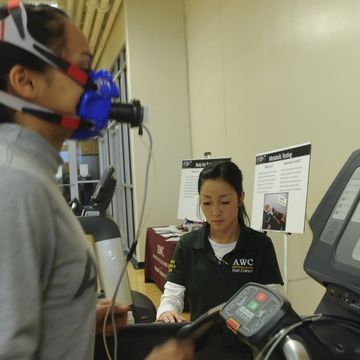When we think about playing around with oxygen levels during training, we usually think about altitude training -- forcing the body to adapt to using less oxygen, so that it becomes more efficient with whatever it can get. But lately I've been hearing an increasing number of mentions of "hyperoxic" training -- wearing an oxygen mask that delivers higher-than-normal levels of oxygen during exercise, so that you can (in theory) go faster and harder before hitting fatigue.
Does it work? As usual, I'm initially skeptical. People have been studying hyperoxic training for several decades now (longer than that, actually -- in fact, Roger Bannister published extensive research on the topic way back in the 1950s, before his four-minute mile). As Bannister's results show, breathing extra oxygen allows you go farther and faster than you'd otherwise be able to go. For example, during a treadmill test at 6.25 mph and 14% grade, Bannister reached failure after 8:45 when breathing normal levels of oxygen (21%); with 66% oxygen, he ran twice as far without reaching failure.
The real question, though, is whether doing this sort of training allows you to run faster when you take the oxygen mask away. There have been a variety of studies that suggest this might or should happen, but I'm unaware of any really good, properly controlled training studies that actually demonstrate training benefits. (I'm happy to be corrected on this if I'm wrong, though!)
The other issue is practicality. It's fine if you're training on a stationary bike or treadmill, but neither of those are optimal training environments. That's the question addressed by a recent study from researchers at the University of Western Australia, who had runners complete an interval workout (10 x 3:00 at 85% vVo2max, with 1:30 rest), and had them breathe 99.5% oxygen during the rest periods rather than the running.
As expected, the level of oxygen saturation in the blood recovered more quickly in the oxygen group than in the normal group. (Typically, oxygen saturation can drop by 8-13% during hard interval workouts.) But that didn't necessarily translate into better outcomes. In particular, this study was trying to find out whether the oxygen would reduce levels of inflammation and oxidative stress following the workout. Here's what they found for interleukin-6, a marker related to inflammation response:
There are no significant differences between the 21% oxygen (NORM) and the 99% oxygen (HYP) groups; the same was observed in a marker of oxidative stress.
So what does this tell us about hyperoxic training? Nothing conclusive. Unlike some training interventions which are purely bogus (Powerband bracelets, for example), extra oxygen clearly produces real and significant physiological effects. The question is whether it's a useful training tool, and if so, exactly how it should be used. After all, running downhill allows you to go faster with less effort, but it hasn't caught on as a revolutionary training technique either.













